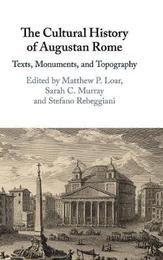
|
The Cultural History of Augustan Rome: Texts, Monuments, and Topography
Hardback
Main Details
Description
This volume wades into the fertile waters of Augustan Rome and the interrelationship of its literature, monuments, and urban landscape. It focused on a pair of questions: how can we productively probe the myriad points of contact between textual and material evidence to write viable cultural histories of the ancient Greek and Roman worlds, and what are the limits of these kinds of analysis? The studies gathered here range from monumental absences to monumental texts, from canonical Roman authors such as Cicero, Livy, and Ovid to iconic Roman monuments such as the Rostra, Pantheon, and Solar Meridian of Augustus. Each chapter examines what the texts in, on, and about the city tell us about how the ancients thought about, interacted with, and responded to their urban-monumental landscape. The result is a volume whose methodological and heuristic techniques will be compelling and useful for all scholars of the ancient Mediterranean world.
Author Biography
Matthew P. Loar is Assistant Professor of Classics at the University of Nebraska-Lincoln, where he specializes in the literary and visual culture of late Republican and early Imperial Rome. He has co-edited, with Carolyn MacDonald and Dan-el Padilla Peralta, Rome, Empire of Plunder: The Dynamics of Cultural Appropriation (Cambridge, 2017). Sarah C. Murray is Assistant Professor of Classics at the University of Toronto. She is the author of The Collapse of the Mycenaean Economy: Trade, Imports, and Institutions 1300-700 BCE (Cambridge, 2017). Stefano Rebeggiani is Assistant Professor of Classics at the University of Southern California. He is the author of The Fragility of Power: Statius, Domitian and the Politics of the Thebaid (2018).
Reviews'... the volume is well produced, with a solid general index ... graduate students and scholars of Augustan Rome, as well as those working at the interstices of texts and monuments, will find many worthwhile individual pieces and points of provocation to chew on in this collection.' Evan Jewell, Bryn Mawr Classical Review
|